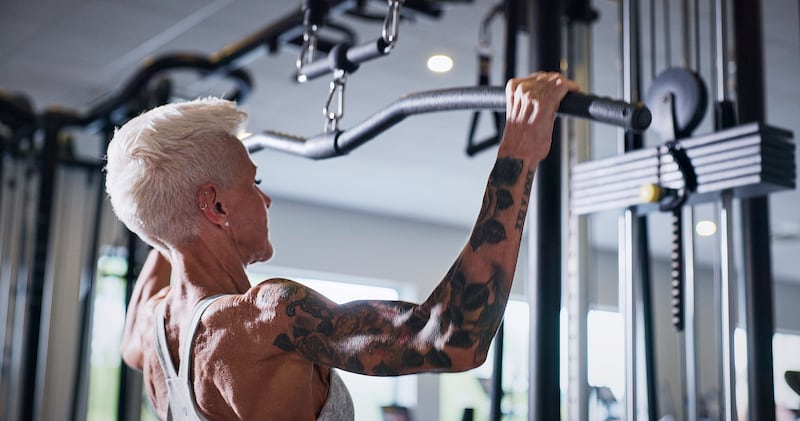Social media algorithms have a field day when work and personal interests converge. At least, that’s my rationale for why everywhere I looked online last year, the merits of strength training “for the older woman” were being flagged.
In gathering expert advice to write on the theme of “successful ageing”, several strands continued to interest me long after the article was published. Multiple scientific studies suggest progressive resistance training increases the likelihood of an extended health span.
Post-menopausal women, in particular, need to guard against weakening bones setting us up for debilitating falls in the future. Vitamin D and calcium supplements can only go so far.
On the wrong side of 60, I reckoned that, in addition to walking the dog twice a day, more all-round, intense activity was needed. But, due to caring responsibilities at home, it would have to be close by and provide a high-ratio of physical benefit versus time invested.
READ MORE
This led me, a lifelong fan of solitary, outdoor exercise, to do something in the autumn of 2024 that I thought I would never do – start paying money to grunt and sweat amid strangers in the confines of an indoor gym, while a trainer shouts “encouragement”.
Madness.
But through one year of doing small group training sessions three times a week, here are seven things I’ve learned:
1. The best gym is the one you actually go to
Obvious, yes. However, proximity counts for a lot, even when price and facilities might seem more important considerations. There will be plenty of reasons (excuses) for not going, so eliminating at least all transport-related ones by choosing somewhere within a short walk or easy cycle of home, if possible, is a good start.
Committing to an early morning session means there is no more drifting through a day with every intention of going out for exercise, until time evaporates or willpower is snuffed out. Hitting the snooze button is the height of selfishness if you have booked a high-demand class place and don’t turn up.

2. It’s never too late to start lifting weights
In the US in the 1980s, a young doctor, Maria Fiatarone, encouraged residents of a Boston nursing home to try a weightlifting programme. Her study, High Intensity Strength Training in Nonagenarians, which showed how in just eight weeks they became stronger and more mobile, began to change the medical view of older people’s frailty.
There has been plenty of scientific research since into how loading muscles brings benefits at any age. “High intensity” is relative to the individual; we all have a baseline that can be improved on.
Mind you, I wish I had started earlier. Stockpiling muscle mass, before we naturally start to lose three to five per cent of it per decade from age 30 onwards, makes a lot of sense in hindsight.
3. The value of being watched over
Worrying less about what others think comes with maturity but the idea of venturing into the natural habitat of gym bunnies still ramped up body insecurities. However, close supervision by trainers builds confidence and keeps you safe, while fellow participants are far too preoccupied with their own efforts to watch anybody else’s.
Signing up for small group training dilutes the cost of one-on-one attention. Good trainers schedule enough variety and incremental demands into programmes to sustain motivation and gains.
[ Lift yourself up: The healing power of strength trainingOpens in new window ]
4. It is not about weight loss
Well, it is certainly not a primary aim. Your body mass index (BMI) may even be nudged upwards through building muscle, although body fat should reduce over time. Personally I am not over-interested in metrics – my watch still only tells the time – but there are body composition scales for those who are.
A bonus though is the inclination to eat more appetite-satiating protein, which contains amino acids that are essential for repairing and growing muscle. The prospect of a workout in the morning is also an incentive to cut down on alcohol, eat less unhealthy food and get a good night’s sleep.
5. Mental health benefits exceed expectations
Coming out of a gym session with a boost of endorphins was no surprise. I had done enough long-distance running in the past to be familiar with the “high” that can bring. Walking, jogging and swimming are also great for untangling thoughts.
However, being unable to think of anything else except keeping going during strength and conditioning sessions was a novelty. A non-toxic way to wipe the mind and enjoy temporary relief from all worries.
6. Stronger body makes life easier
The ease of carrying the lawnmower through our terraced house for the first grass cut of the year was a heartening reminder that I ended last winter stronger than I began it. Day-to-day physical work as a carer became noticeably less taxing and there was a new, feel-good edge to running up steps and walking uphill.
Options abound for starting resistance training, whether at home (see strength exercises on hse.ie for a gentle introduction), or through classes of all sorts in the community or joining a neighbourhood gym. It is about finding something that suits.
[ How hard do you have to work to build muscle?Opens in new window ]

7. There’s no stopping
“It never gets any easier,” a long-time gym member told me cheerily in my first week there. Perversely perhaps, that is the appeal. Pushing yourself to your limits by using increasingly heavier, dumbbells, barbells and kettlebells, means it is always a struggle. But an addictive sense of wellbeing from feeling stronger, along with the fear of “use it or lose it”, are compelling reasons to stick with the programme.
The circumstances that drove me to start strength training in small group classes were changed utterly by the death of my husband, Philip, in June. Yet, in the free fall of grief, it has been a welcome, steadying routine, offering self-care and social interaction.
The gym maxim that if you just keep turning up, progress will follow, seems equally apt for life right now.


















